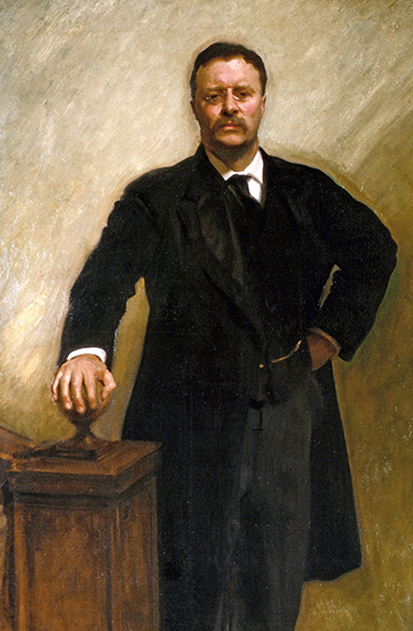As John Singer Sargent started to become famous for his portraits he started to paint men of power like Theodore Roosevelt and John D. Rockerfeller
By 1903 when john Singer Sargent was invited to the White House to paint President Roosevelt his style had already started to be critiqued by more modernist painters.
Artistic trends like futurism and cubism had started emerging and by this point John Singer Sargent had somewhat began to be looked down on.
Many argue that it was his fierce loyalty to the traditional that won him the invite to the White House for a week in February to paint a portrait of the President.
Despite changing trends Sargent was still the most popular Anglo-American portraitist of the time. His popularity as a portraitist was at it's height in 1900 and he was still very much riding the wave when he came to paint the President.
The Painting Experience
To get the painting completed Theodore Roosevelt invited John Singer Sargent to stay with him at the White house for a week. There have been many stories and rumours circulating about John Singer Sargent's time at the Presidents home.
It is unlikely that Singer Sargent was expecting the President to be as strong willed as he was. The artist found the President's incredibly strong will daunting from the start of the project, which added to tension between the two men during his time at the White House.
Finding a suitable place to paint the President was also a challenge for John singer Sargent. Roosevelt didn't have the patience required by John Singer Sargent to find a room with suitable lighting and became visibly annoyed by the arduous task of finding "the perfect light".
As a room on the first floor could not be agreed on the two men climbed the stairs to the next level up, with Roosevelt commenting that he didn't Thing Singer Sargent knew what he wanted. Sargent replied that he did not think Roosevelt knew what was to be involved when posing for a portrait.
It was at this point, Roosevelt swung around being already at the top of the stairs and replied "don't I?", and it was here that John Singer Sargent found the perfect positioning for the portrait. Singer Sargent informed Roosevelt this would be where they would complete the painting.
Even though they had found the perfect position and light, the President's busy schedule frustrated Singer Sargent.
Reduced to just half an hour each lunch time, the artist felt rushed and was not sure what the President's reaction would be to the finished painting. Roosevelt considered it a success and praised the portrait for the rest of his life.
The Portrait
John Singer Sargent's portrait of President Roosevelt shows him on the landing with one arm on the post facing the audience. He has one hand behind his back in a standing position. The portrait is painted in the style of realism which is traditional for portraits of subjects like US Presidents.
It was created using oil on canvas which was typical of John Singer Sargent's works. Although John Singer Sargent felt rushed while creating this painting, Roosevelt wrote to his son that he "like this painting enormously".
Similar Works
John Singer Sargent was perhaps more famous for his portraits of women. His portrait of the actress Ellen Terry playing Lady Macbeth is possibly one of the most famous portraits of all time. This does not mean that the artist shied away from painting portraits of men. Another man of power that John Singer Sargent painted a portrait of was John D. Rockerfeller.
As Rockerfeller was able to dedicate more time to the portrait sitting you can see that it is more natural than his painting of Roosevelt. This portrait depicts Rockerfeller relaxed on a chair with his arms folded, facing away from the audience. This again was painted int he realism style using oil on canvas. If you make a direct comparison between the two you are able to make out the lack of time Sargent had to paint Roosevelt compared to the time he had to paint Rockerfeller.
Between 1890 and 1916, many wealthy patrons demanded portraits from John Singer Sargent. Because he would not have had time to create them all using the medium of oil on canvas, he dashed them off quickly as charcoal portraits and called them "mugs". 46 of them were exhibited at the Royal Society of Portrait Painters in 1916.




